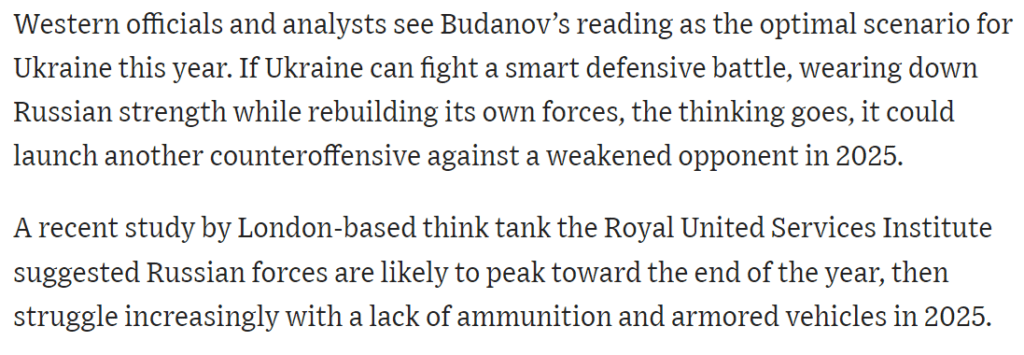Everyone knows, or at least has heard of, disinformation – the intentional distortion of information for mostly malicious purposes. The Infolight.UA research and analysis group has repeatedly analyzed this issue both in training sessions and with specific examples (training recordings are available on our YouTube channel).
Less well known is the phenomenon of misinformation, when distorted information is created and spread unintentionally (relevant trainings are also among our videos). And today we want to draw your attention to just such a case.
On February 21, The Wall Street Journal publishes an article “Ukraine’s Military Spy Chief Says Russia Will Struggle to Keep Up the Fight,” which includes, among other things, a fragment:
Western officials and analysts see Budanov’s reading as the optimal scenario for Ukraine this year. If Ukraine can fight a smart defensive battle, wearing down Russian strength while rebuilding its own forces, the thinking goes, it could launch another counteroffensive against a weakened opponent in 2025.
A recent study by the London-based think tank the Royal United Services Institute suggested that Russian forces are likely to peak toward the end of the year, then struggle increasingly with a lack of ammunition and armored vehicles in 2025.

The Ukrainian translation is as follows:
Western officials and analysts believe that Budanov’s forecast is the best-case scenario for Ukraine this year. If Ukraine can wage a smart defense, depleting Russian forces while rebuilding its own, they believe it will be able to launch a new counteroffensive against a weakened enemy in 2025.
A recent study conducted by the Royal United Services Institute, a London-based think tank, found that Russian troops are likely to reach their peak at the end of this year and will increasingly run out of ammunition and armored vehicles in 2025.
Please note that the words about 2025 belong to “Western analysts” and not to the head of the Main Intelligence Directorate of the Ministry of Defense of Ukraine.
There is no other mention of 2025 in the text, which means that Kirill Budanov did not say anything about 2025.
Nevertheless, a number of Ukrainian media outlets ran the following headlines:
“Ukraine could launch a new counteroffensive in 2025 – WSJ: What Budanov says“
“Ukraine could launch a new counteroffensive in 2025 – WSJ”.
“Russia is deflating: Budanov predicts counteroffensive, but not in 2024”.
This is an erroneous interpretation of the article, which most likely arose because access to the original material is paid for and the editors of the news feeds did not want to pay money for access.
However, there is another important detail here – the Russian media were the first to give such an interpretation of the material, between 02:00 and 06:00 on February 21. The Ukrainian news started appearing at 7 am. And there is a possibility that the publications that ran the story used Russian news aggregators.
It is clear that none of the Ukrainian media outlets wanted to spread this information deliberately, so this is an example of misinformation.
We urge our colleagues to be more attentive to such situations, as fake statements of this level, allegedly from the head of intelligence, can have negative consequences.


Leave a Reply